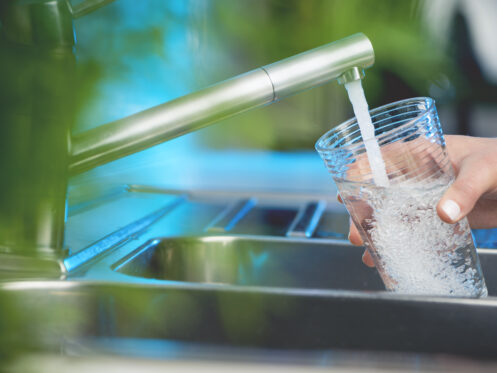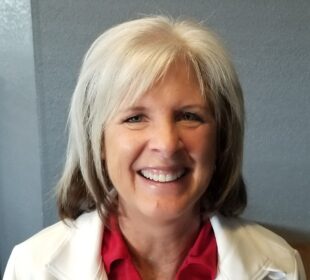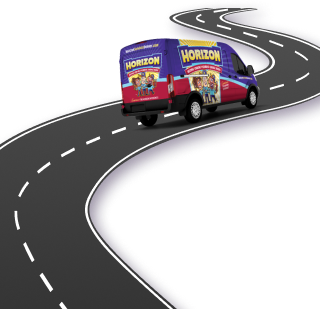If you’re concerned about the quality of your family’s drinking water, a home water filtration system can provide peace of mind. The challenge is that there’s a wide range of water purification approaches. Which is best for you depends on many factors.
What Is the Healthiest Way to Filter Tap Water?
A core goal should be to clean the water without introducing any byproducts. Be mindful that people and pets need minerals in their water for a healthy balance. Distillation, for instance, will remove all the healthy minerals too, which is bad for your family long term. It’s also important to understand your water purification goals. Perhaps you just want to improve taste, smell, and clarity, or maybe you want advanced protection against chemicals and pathogens.
Does It Matter if You Have Well or Municipal Water?
The Environmental Protection Agency (EPA) recommends annual testing of well water. With municipal water, you can access annual water quality reports that are publicly available. Well water is more prone to larger particulates, so a prefilter is more important.
Home Water Filtration Options
There are three fundamental concepts to understand when exploring home water purification. Those are point of use (POU), point of entry (POE), and reverse osmosis (RO).
POU
POU water purifiers clean water for a single tap. A common example is a countertop or under-sink canister filter for a kitchen faucet. There are also POU water filters for refrigerators and coffeemakers. While often the cheapest option, there are some limitations. They serve only one tap, provide a relatively low volume of clean water, and offer limited filtration options.
POE
POE water purifiers function between the main water line and the home plumbing system. This whole-home approach lets the system filter all your water before it enters your home. You’ll enjoy filtered water from every faucet and showerhead and for all water-using appliances. These systems can deliver a high volume of filtered water. In fact, they can provide enough to meet even a large household’s peak daily demand. While they are more expensive initially, whole-house systems are often more cost-effective over time.
RO
Traditional water filtration involves forcing water through a series of filter media stages to clean it. Reverse osmosis involves using pressure to move water through a semipermeable membrane. In doing so, it reverses the natural osmosis, which is where water moves from a low to a high concentration. An advantage of RO is that it removes over 99% of impurities without needing all the stages a traditional water purifier would. There are some disadvantages. RO removes most good minerals too, which means you’ll need a remineralization post-filter. In addition, RO is a slower process than traditional filtration. That means RO systems for homes can’t generally provide the higher clean water volumes that whole-house water purifiers can.
Water Filtration Media
What your water purifier can filter depends on its media stages. Note that these stages aren’t exclusive to whole-house water filters. You can opt for them as pre- and post-filters for RO systems as well.
Sediment Filters
Sediment filters trap particulates as the water flows through them. Most water purifiers and RO systems have a sediment prefilter. It’s generally a cheaper media that traps the largest particles and preserves the more expensive media. RO systems have a semipermeable membrane. Water purifiers have a primary sediment filter. The industry assesses sediment filters based on their absolute pore size. The smaller it is, the finer particles the filter can trap. Many top water purifiers have a small enough pore size to trap cysts and other parasites.
Activated Carbon
Activated carbon or charcoal provides both mechanical and adsorptive filtration. Consider that many canister filters don’t have a dedicated sediment filter. They instead use the gaps between the charcoal granules to trap particulates. This manufactured form of carbon is also very effective at improving the smell, taste, and texture of water. It also adsorbs gases and chemicals. Municipal water often has chloramine and fluoride in it, but there can be much more dangerous chemicals, including:
- Steroids
- Pharmaceuticals
- Pesticides and herbicides
- PFAs or “forever chemicals”
Ultraviolet Light
While sediment filters can trap some pathogens, there are limitations. For more robust pathogen control, some water purifiers have an ultraviolet (UV) lamp. There are even RO systems that use a UV lamp as a post-filter. That’s because a germicidal light can neutralize nearly all the bacteria, viruses, and other pathogens in the water.
Capacity
Another important consideration is the capacity of your water filtration system. If the capacity is too low, you may run out of clean water or experience low water pressure or other issues.
Flow Rate
The industry generally measures whole-house water purifiers by flow rate or, more specifically, gallons per minute (GPM). Every fixture and water-using appliance in your home uses a certain GPM. The total flow rate of your system must exceed your household’s peak demand. If you overtax the system, you could experience low water pressure. You may also have unclean drinking water and damage your system’s filter media.
Gallons Per Day
As mentioned, RO is a much slower process than traditional water filtration. The industry generally measures RO systems in gallons per day (GPD). The typical household requires between 50 and 100 GPD, but there are much higher-capacity systems. An RO system can’t generally meet the total water needs of a home. That said, it can feed multiple fixtures and appliances throughout a home.
Certifications
There are many certifications that manufacturers can earn for their water purification products. The two most notable for the average consumer are NSF and WaterSense.
NSF
NSF International is an independent organization that develops water quality standards. The Centers for Disease Control and Prevention recommends looking for the NSF label. It will indicate that NSF International tested and certified the system. It will also indicate to what standards, which lets you know precisely what the system can filter.
WaterSense
WaterSense is an EPA program similar to ENERGY STAR but with a focus on water conservation. This is particularly important for RO systems, which use more water than they deliver. An RO system with certification gives you peace of mind that your system minimizes water waste.
Water Softening
Whether water is soft or hard reflects how much calcium and magnesium are present. These minerals are safe to drink, but they can leave behind deposits. That limescale can reduce energy efficiency, lower water pressure, cause rust, and much more. If you have moderately hard water, an RO system or a water purifier with a softening stage is usually enough. For harder water, you’ll generally want a dedicated water softener alongside your filtration system.
Water Conditioning
RO systems and water purifiers can have conditioning stages as well. The remineralization and water-softening stages mentioned earlier are examples of this. There are also conditioners to adjust pH, remove iron, and so on.
Water Filtration System Installation in the Denver Metro Area
Horizon Services is an HVAC and plumbing company with locations in Englewood and Denver, CO. We employ NATE-certified technicians and have served this region since 1998. Our business is proud to be EPA-certified and install all water purification brands and technologies. To learn more about which water purifier is right for your home, call us with questions and to set up an in-home consultation.


